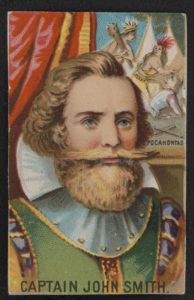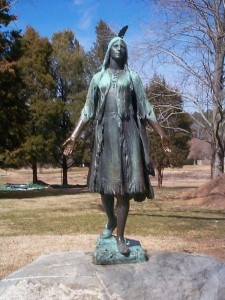Jamestown, Virginia, became the first permanent English colony in America in 1607. Three ships, the Susan Constant, the Godspeed, and the Discovery brought Captain John Smith and others to American shores. The ill-prepared colonists had left England on December 20, 1606. Children could learn more at: http://www.nps.gov/jame/index.htm.
James VI, King of Scotland, also became King of England in 1603. He took the name James I in England. He succeeded Queen Elizabeth I, who had no children. The king had the Bible translated into English (King James Version). Jamestown and the James River were named after him.
 John Smith became the leader of Jamestown Colony Council in Virginia in 1608. Jamestown, which had been founded on May 14, 1607, was struggling because the colonists were more interested in finding nonexistent gold than by providing for basic needs. When Smith took over, he stated, “He who shall not work shall not eat.” The group continued to struggle, but eventually his philosophy took root. Children could learn more at: John Smith.
John Smith became the leader of Jamestown Colony Council in Virginia in 1608. Jamestown, which had been founded on May 14, 1607, was struggling because the colonists were more interested in finding nonexistent gold than by providing for basic needs. When Smith took over, he stated, “He who shall not work shall not eat.” The group continued to struggle, but eventually his philosophy took root. Children could learn more at: John Smith.
Jamestown was burned by Nathaniel Bacon and his men in 1676. This action later became known as part of Bacon’s Rebellion. They were rebelling against Governor Sir William Berkeley and his laws regarding control of Jamestown. Berkeley fled, and Bacon became the colony’s leader. He died shortly after taking control. Berkeley regained leadership. However, Berkeley was replaced a year later; and rebellion became unnecessary. Children could learn more at: Bacon’s Rebellion.
Williamsburg, Virginia, began restoration processes in 1926. Colonial Williamsburg, along with Jamestown and Yorktown, form the Historic Triangle. About four million people visit the region each year. Colonial Williamsburg has a great website for children at: Williamsburg.
Virginia Company left England in 1606 to establish the first colony, Jamestown, in America. Three ships, the Godspeed, the Discovery, and the Susan Constant carried approximately 120 people to their new land. The ships landed May 14, 1607. Older children could read an excellent book, Blood on the River: Jamestown, 1607, by Eliza Carbone. Children could learn more at the National Parks Site: Jamestown.
